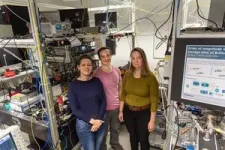(Press-News.org) As a physical quantity pressure is encountered in various fields: atmospheric pressure in meteorology, blood pressure in medicine, or even in everyday life with pressure cookers and vacuum-sealed foods. Pressure is defined as a force per unit area acting perpendicular to a surface of a solid, liquid, or gas. Depending on the direction in which the force acts within a closed system, very high pressure can lead to explosive reactions in extrem cases, while very low pressure in a closed system can cause the implosion of the system itself. Overpressure always means that the gas or liquid pushes against the walls of its container from the inside, like a balloon expanding when more air is added. Regardless of whether it's high or low pressure, the numerical value of pressure is always positive under normal circumstances.
However, liquids exhibit a peculiar characteristic. They can exist in a specific metastable state corresponding to a negative pressure value. In this metastable state, even a tiny external influence can cause the system to collapse into one state or another. One can imagine it as sitting at the top of a roller coaster: the slightest touch on one side or the other sends you hurtling down the tracks. In their current research, the scientists are examining the metastable state of liquids with negative pressure. To achieve this, the research team combined two unique techniques in a study published in Nature Physics to measure various thermodynamic states. Initially, tiny amounts - nanoliters - of a liquid were encapsulated in a fully closed optical fiber, allowing both highly positive and negative pressures. Subsequently, the specific interaction of optical and acoustic waves in the liquid enabled the sensitive measurement of the influence of pressure and temperature in different states of the liquid. Sound waves act as sensors for examining negative pressure values, exploring this unique state of matter with high precision and detailed spatial resolution.
The influence of negative pressure on a liquid can be envisioned as follows: According to the laws of thermodynamics, the volume of the liquid will decrease, but the liquid is retained in the glass fiber capillary by adhesive forces, much like a water droplet sticking to a finger. This results in a "stretching" of the liquid. It is pulled apart and behaves like a rubber band being stretched. Measuring this exotic state typically requires complex equipment with heightened safety precautions. High pressures can be hazardous endeavors, particularly with toxic liquids. Carbon disulfide, used by the researchers in this study, falls into this category. Due to this complication, previous measurement setups for generating and determining negative pressures have required significant laboratory space and even posed a disturbance to the system in the metastable state. With the method presented here, the researchers have instead developed a tiny, simple setup in which they can make very precise pressure measurements using light and sound waves. The fiber used for this purpose is only as thick as a human hair.
"Some phenomena which are difficult to explore with ordinary and established methods can become unexpectedly accessible when new measurement methods are combined with novel platforms. I find that exciting," says Dr. Birgit Stiller, head of the Quantum Optoacoustics research group at MPL. The sound waves used by the group can detect temperature, pressure, and strain changes very sensitively along an optical fiber. Furthermore, spatially resolved measurements are possible, meaning that the sound waves can provide an image of the situation inside the optical fiber at centimeter-scale resolution along its length. "Our method allows us to gain a deeper understanding of the thermodynamic dependencies in this unique fiber-based system," says Alexandra Popp, one of the two lead authors of the article. The other lead author, Andreas Geilen, adds: "The measurements revealed some surprising effects. The observation of the negative pressure regime becomes abundantly clear when looking at the frequency of the sound waves."
The combination of optoacoustic measurements with tightly sealed capillary fibers enables new discoveries regarding the monitoring of chemical reactions in toxic liquids within otherwise difficult-to-investigate materials and microreactors. It can penetrate new, hard-to-access areas of thermodynamics. "This new platform of fully sealed liquid core fibers provides access to high pressures and other thermodynamic regimes," says Prof. Markus Schmidt from IPHT in Jena, and Dr. Mario Chemnitz, also from IPHT in Jena, emphasizes: "It is of great interest to investigate and even tailor further nonlinear optical phenomena in this type of fiber." These phenomena can unlock previously unexplored and potentially new properties in the unique thermodynamic state of materials. Birgit Stiller concludes: "The collaboration between our research groups in Erlangen and Jena, with their respective expertise, is unique in gaining new insights into thermodynamic processes and regimes on a tiny and easy-to-handle optical platform."
END
Light and sound waves reveal negative pressure
2023-09-25
ELSE PRESS RELEASES FROM THIS DATE:
Predicting how climate change affects infrastructure without damaging the subject
2023-09-25
A digital twin may sound like something out of a science fiction film, but Pitt engineers are developing new technology to make them a reality in our campus and beyond.
Digital twins – a model that serves as a real-time computational counterpart – can be used to help simulate the effects of multiple types of conditions, such as weather, traffic, and even climate change. Still, life-cycle assessments (LCAs) of climate change’s effects on infrastructure are still a work-in-progress, leaving a need ...
New qubit circuit enables quantum operations with higher accuracy
2023-09-25
In the future, quantum computers may be able to solve problems that are far too complex for today’s most powerful supercomputers. To realize this promise, quantum versions of error correction codes must be able to account for computational errors faster than they occur.
However, today’s quantum computers are not yet robust enough to realize such error correction at commercially relevant scales.
On the way to overcoming this roadblock, MIT researchers demonstrated a novel superconducting qubit ...
Could this new hydrogel make HIV therapy more convenient?
2023-09-25
A new injectable solution that self-assembles into a gel under the right conditions could help manage HIV unlike any currently available methods, researchers have found.
The gel releases a steady dose of the anti-HIV drug lamivudine over six weeks, suggesting people living with HIV could have new therapy that doesn’t require a daily pill regimen to prevent AIDS.
“The primary challenge in HIV treatment is the need for lifelong management of the virus, and one way to address this is to reduce dosing frequencies to help patients stick to medical regimens,” said Honggang Cui, a Johns Hopkins University chemical and biomolecular engineer ...
Study finds immune cells in older adults resemble those in newborns and children, but fall short in virus detection
2023-09-25
Study finds immune cells in older adults resemble those in newborns and children, but fall short in virus detection
A world-first discovery has revealed special immune cells called ‘killer T cells’ in older adults, directed against influenza viruses, closely resemble those found in newborns and children, but struggle to recognise infected cells – a finding that unlocks the potential for the development of better vaccines and therapies tailored to different age groups.
Killer T cells (also known as CD8+ T cells) play a critical role in the immune system by eliminating virus-infected cells. ...
Wang studying novel & interpretable statistical learning for brain imaging data
2023-09-25
Wang Studying Novel & Interpretable Statistical Learning For Brain Imaging Data
Lily Wang, Professor, Statistics, has received a total grant of $1,199,772 ($299,987 for the first year) from the National Institutes of Health for the project: "SCH: Novel and Interpretable Statistical Learning for Brain Images in AD/ADRDs." This funding began in Sept. 2023 and will end in late April 2027. This grant was reviewed by the joint NSF/NIH Smart Health and Biomedical Research in the Era of Artificial Intelligence and Advanced Data Science (SCH) program.
Alzheimer’s ...
NCCN Senior Director Evelyn Handel Zapata is named a ‘40 Under 40 in Cancer: Emerging Leader’ for milestone work improving safe use of chemotherapy
2023-09-25
PLYMOUTH MEETING, PA [September 25, 2023] —Evelyn Handel Zapata, PharmD, BCPS, BCOP, Senior Director of Drugs & Biologics Programs at the National Comprehensive Cancer Network® (NCCN®) was named a 40 Under 40 in Cancer: Emerging Leader at a national reception in Chicago in June. This achievement comes as the NCCN Chemotherapy Order Templates (NCCN Templates®) program celebrates its 15th anniversary and launches new resources for a type of pediatric lymphoma today.
40 Under 40 in Cancer is an awards initiative that recognizes ...
Modelling of adhesive technology sheds new light on prehistoric cognition
2023-09-25
Studying prehistoric production processes of birch bark tar using computational modelling reveals what kinds of cognition were required for the materials produced by Neanderthal and early modern humans. Researchers of Team Langejans in the Materials Science and Engineering (MSE) department (TU Delft) recently published two papers on one of the world’s oldest transformative technologies, publishing their findings in Nature Scientific Reports.
Measuring complexity
Birch bark tar is the first time we see evidence of creating a new material, ...
Two Salk Institute faculty members earn V Foundation awards for cancer research
2023-09-25
LA JOLLA (September 25, 2023)—Salk Institute Assistant Professors Christina Towers and Deepshika Ramanan were named V Scholars by the V Foundation for Cancer Research. They will each receive $600,000 over three years to fund their unique cancer research goals.
“On behalf of all our Salk colleagues, we are proud to congratulate Christie and Shika on this outstanding recognition,” says Salk President Gerald Joyce. “Through their dedication and innovative approaches, they both embody Salk’s mission to push the boundaries of knowledge and make meaningful impact in the world.”
Towers was named to the first class of recipients of V Foundation’s A Grant ...
People with long COVID have distinct hormonal and immune differences from those without this condition
2023-09-25
Long COVID patients have clear differences in immune and hormone function from patients without the condition, according to a new study led by the Icahn School of Medicine at Mount Sinai and Yale School of Medicine.
The research, published in the September 25 issue of Nature, is the first to show specific blood biomarkers that can accurately identify patients with long COVID.
“These findings are important—they can inform more sensitive testing for long COVID patients and personalized treatments for long COVID that have, until now, not had a proven scientific rationale,” says Principal Investigator David Putrino, ...
New vaccine technology could protect from future viruses and variants
2023-09-25
Studies of a ‘future-proof’ vaccine candidate have shown that just one antigen can be modified to provide a broadly protective immune response in animals. The studies suggest that a single vaccine with combinations of these antigens – a substance that causes the immune system to produce antibodies against it – could protect against an even greater range of current and future coronaviruses.
The vaccine antigen technology, developed by the University of Cambridge and spin-out DIOSynVax in early 2020, provided protection against all known variants of SARS-CoV-2 – the virus that causes COVID-19 – as well as other ...






